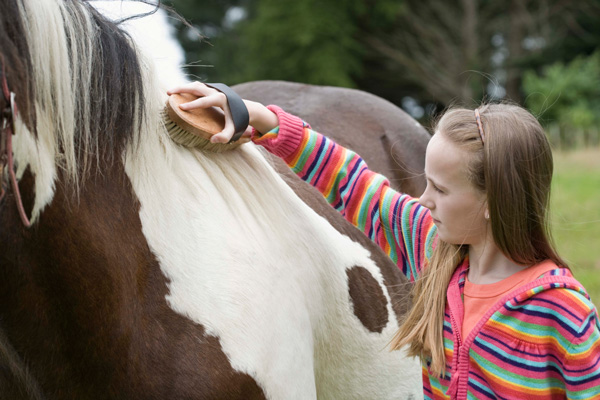
To protect your horse and saddle, a properly fitted saddle pad is imperative. More than a matter of comfort, a proper saddle pad protects your horse’s back and also helps preserve your saddle. Choosing the right pad will depend on several criteria. You won’t be disappointed if you take the time to figure out the best saddle pad match for you and your horse.
Tips for Finding the Right Saddle Pad
- Match the Horse’s Contours. Matching the contours of the horse’s back as well as the contours of the underside of the saddle is vital to having a saddle pad that won’t apply pressure to the horse’s spine or withers. There are even pads available that are made specifically for high-withered or mutton-withered horses.
- Find the Right Style. There are three basic styles of saddle pads–shaped, square, and half pads. In the show ring, riders doing Dressage will typically use square pads, while shaped pads are most popular in the Hunter/Jumper shows. Eventers are commonly seen with either style pad customized to their individual colors. Half pads are used in all disciplines and can be used alone or in conjunction with a square or shaped pad.
- Choose the Right Size. Be sure to match the type of pad with your type of saddle. Pads are typically made with different style saddles in mind. Dressage pads will have a straighter cut and will accommodate a longer flap, while a close contact pad will have a forward cut and shorter length. All purpose pads fall somewhere in the middle and tend to vary a bit more in dimensions. Pony or Children’s saddle pads are also available for saddles that measure less than 16 inches. Ensure the pad extends slightly beyond the saddle edge, but not beyond the horse’s last rib.
- A Pad to Improve Saddle Fit. Saddle pads should not be used as a means to rectify an ill-fitting saddle. Always look to find a saddle that fits your horse as best as possible. Having said that, there are cases where saddle pads can help improve saddle fit. For example, an unevenly developed horse may benefit from a custom-fit pad to protect from painful pressure. An underdeveloped horse after a long break from work is another example of a situation in which a specialty pad may be a viable option to improve saddle fit. These situations can often be tackled with the use of a half pad, or a pad with shims.
- Choose the Best Material. Saddle pads come in a variety of material choices. Fleece and cotton are two of the most popular choices because of their wicking capabilities. The fleece may be synthetic or can be actual sheepskin or wool. Cotton and synthetic fleece pads are typically less expensive and are easy to care for. Sheepskin or wool pads can be pricey and requires specialized care, but they are able to absorb up to three times its weight in water, while cotton will only absorb its initial weight. Foam, gel and polyester batting are commonly used in the pad’s interior to add some additional cushioning and shock absorption. Just remember that if your saddle fits perfectly, you may not have room to use a thick pad without changing the way the saddle sits on your horse.
Tips for Saddle Pad Use and Care
Alleviate Pad Pressure. Once the saddle pad and saddle are on your horse, be sure to pull up the front of the pad. Do this in a manner that moves it up into the channel (gullet) of your saddle. A flat-lying pad will rub against your horse and can also interfere with the horse’s movement by putting pressure on the spine.
Keep pads clean. Dirty pads can rub and cause saddle sores on your horse. Hang your pad upside down to allow it to air dry after rides. Here are some tips for taking care of your saddle pads:
- Never set your pad down on materials that can cause it to pick up extra dirt or debris that might be transferred to your horse’s back.
- Use a dandy brush to clean your pad between washings.
- Wash your pads on a regular basis to remove sweat and dirt. Sheepskin and wool pads typical need special soaps made specifically to wash these items. Be sure to hang dry your pads to keep them from shrinking or changing size.
- Always follow the cleaning instructions on your pad for the best results.
Check Your Fit Often. Similar to the way the human body changes with age and wear, a horse’s body will also change. The saddle pad you’re using now might be ideal for your horse, but that may change. Keep an eye on your horse’s muscling and shape as he develops as well your saddle fit to ensure use of the appropriate pad. You may need to change which pad you use at varying times of the year. A thicker pad may not work well when you horse has extra hair or after an inactive winter, when your horse may be a bit heavier and softer. Regularly check the saddle pad and how it’s working for your horse’s body to ensure the best possible comfort and protection for your horse.
Jessica Adcock is a lifelong equestrian and a member of the e-commerce team at Dover Saddlery, a leading retailer of quality English horse tack, supplies and riding apparel for horse and rider.



